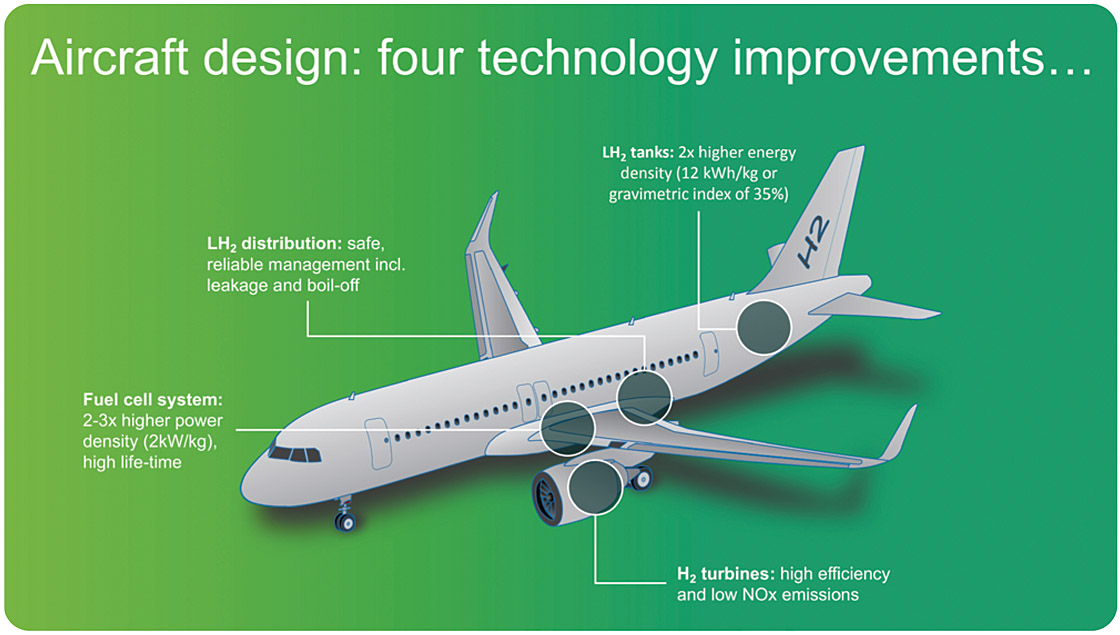Green hydrogen shows real potential to power aviation. On what areas does Clean Aviation focus its efforts?
 Hydrogen presents several major advantages in achieving the goal of climate-neutral aviation. It allows for the complete elimination of CO2 emissions during flight and throughout its entire life cycle when produced using a carbon-free process. However, it is not without its challenges, and we cannot bet solely on one horse or only on one solution for sustainable aviation.
Hydrogen presents several major advantages in achieving the goal of climate-neutral aviation. It allows for the complete elimination of CO2 emissions during flight and throughout its entire life cycle when produced using a carbon-free process. However, it is not without its challenges, and we cannot bet solely on one horse or only on one solution for sustainable aviation.
Our €4.1 billion programme, cofunded by the European Union, explores innovative hybrid-electric concepts, ultra-efficient aircraft architectures, and disruptive hydrogen-powered technologies for the next generation of aircraft. Our innovative technologies will help reduce net emissions of greenhouse gases for commercial air travel by no less than 30% for short-medium and for regional range compared to the best aircraft models available today. Our programme's PHASE 1, running until 2025, focuses on the identification of high-potential technologies and disruptive aircraft concepts. PHASE 2 will integrate and demonstrate by 2028 – 2030 their potential impact to reduce greenhouse gases and support the launch of disruptive new products entering into service by 2035.
Concerning hydrogen propulsion to power future aircraft, we focus our efforts on hydrogen-direct burn and fuel cell-based propulsion. The first means replacing kerosene by hydrogen, and the second covers the potential of mixing both oxygen through the air and hydrogen to produce electricity. Beyond such propulsion concepts, we are also looking at hydrogen storage on board aircraft. We need to look at the aircraft architecture, define the storage device but also make sure to be able to keep the liquified hydrogen at the very low temperature of – 253 degrees Celsius. Other challenges to be addressed in synergy with Clean Hydrogen are how to re-fuel, how to integrate it all into airport infrastructure and of course ensure that everything is safe both on the ground and during flight. That is why the European Union Aviation Safety Agency (EASA) participates in our projects to comply with certification requirements.
Overall, I am proud to say that Europe is one of the world leaders in pursuit of sustainability goals. Our work supports the European Green Deal and will benefit from ReFuelEU Aviation. This European initiative aims at accelerating the scale up and production of sustainable aviation fuel, also comprising hydrogen. Moreover, our research into disruptive technologies matches our ambitions as a founding member of the Alliance for Zero-Emission Aviation (AZEA).
What are some key examples of Clean Aviation projects related to hydrogen?
Our programme's first PHASE is organised around two calls for proposals. Call 1, with a budget of €1700 million composed of EU funding (€654 million) and private members contribution, brought together a wide array of public and private partners, research centres and academia from all across Europe to work on 20 daring projects. Six of them are dedicated hydrogen-powered aircraft projects, representing 24% of the total effort of the call 1.
The CAVENDISH and HYDEA projects, led by Rolls Royce and Avio Aero respectively, cover the maturation of hydrogen direct-burn concepts. The Honeywell-led NEWBORN project looks at the next generation of high-power fuel cells. Aciturri leads the H2ELIOS project, which looks at the necessary technologies required to store hydrogen on board. The last two projects, FLHYing Tank and HYPOTrade, led by Pipistrel, are investigating all aspects related to hydrogen storage on board and the potential of fuel cells for use and testing on smaller aircraft during flight.
Our second call for proposals, with €152 million in EU funding (€380 million of budget), complements our first call projects in preparing all the necessary elements for ground and flight test activities. Three topics are specifically dedicated to hydrogen powered aircraft.
They will investigate topics such as engine and aircraft fuel distribution systems, as well as a multi-megawatt fuel cell propulsion system. I am eager to see the results of these projects, which will help pave the way for the entry into service of new highly efficient aircraft by 2035.
How important is collaboration to reach shared climate-neutrality objectives?
Clean Aviation will not succeed on its own. The required investment in reducing aviation's footprint is substantial, hence we bring key players in the aviation field together.
It is important to collaborate at European, national and regional levels. Last year, we signed a Memorandum of Understanding with EASA and another one earlier this year with the Clean Hydrogen Partnership to strengthen cooperation with key players on research and innovation. We are also liaising with national authorities in France and Germany, with more to come, to streamline efforts.
At regional level, we have recently signed Memoranda of Cooperation with the Campania region in Italy and the Occitanie region in France to accelerate the maturation and demonstration of low-emission aircraft technologies. As often said by Axel Krein, Clean Aviation Executive Director: "we need to fly in formation".
We simply cannot fail to meet our climate neutrality objectives by 2050 and have a future where clean air transport is the norm.
